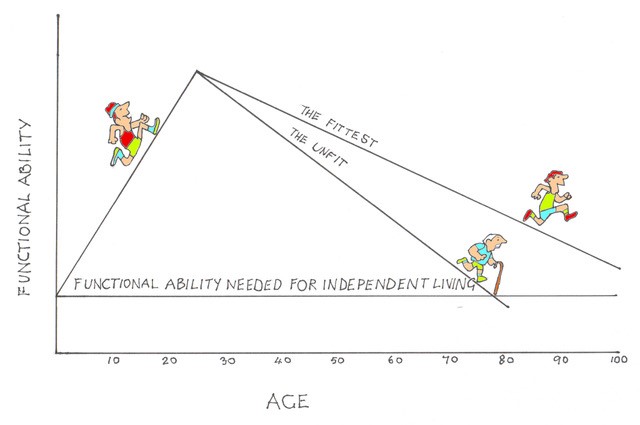PREVENTING FRAILTY
Frailty and physical fitness
Frailty is mainly the result of an accumulation of long-term physical inactivity and one or more of the degenerative diseases associated with ageing. These are all promoted by lack of exercise and thus the main risk factor for the development of frailty is insufficient physical activity – over a very long period. The idle and the sedentary are those at risk. The key may be found in the difference between chronological age and physiological age. We are all aware of people who seem much younger than their real age would suggest – and increasingly of people who seem much older than their real age. This difference between chronological age (how long have we been around) and physiological age (how well can we perform) is measurable and enormous differences are apparent. In the FIT study in the US nearly 60,000 subjects of all ages were assessed. Fitness levels were used to assess physiological age and at each chronological age fitness varied enormously – with differences of from 18 to 38 years between chronological and physiological age.
The effects of exercise
Physical fitness is a product of a number of factors including age, hormonal changes, heredity, socioeconomic status etc, but only one risk factor is easily influenced by the individual – the level of physical activity. This is well illustrated by the findings in a study of over 500 members of a running club, aged 50 or more1. They were followed up over nineteen years and compared to a similar number of non-running members of the same community. At the start of the study the disability scores were low in both groups. This remained so in the runners over the whole period of follow-up. However the disability scores in the non-runners rose steadily throughout the nineteen years. The average time until the onset of measurable disability was 16 years later for the runners compared with the controls. The health gap between the groups increased through the period of study and was still widening into the tenth decade of life.
Exercise, disability and dependency
The improved health status of elderly people who have exercised regularly has been emphasised by another study which found that the average 65-year-old can expect an additional 12.7 years of healthy life – meaning that he will live without disability until aged 77.7. Highly active 65-years-olds, however, have 18.4 years of further healthy life expectancy – they will remain disability-free until age 83.4.
Frailty leads to “terminal dependence” which is the interval between total independence and death. It is the idle and inactive who not only die earlier but also suffer a prolonged period of dependence at the end of life. Regular exercisers keep themselves fit, flexible and strong and also reduce their chances of developing other diseases which contribute to frailty – heart disease, obesity, lower limb arthritis, diabetes and dementia.
Investing in your future
The American College of Sports Medicine has suggested that it is helpful to look at your body as a nest egg — just like your money2. Invest it its future by making exercise a regular part of daily living. No matter at what point in your life these efforts begin, it is never too late, And the investment can be tailored to your health, your inclinations, your capabilities, your goals and your resources. Just do it! The shape of your future depends upon it.
- doi: 10.1001/archinte.168.15.1638
- DOI: 10.1249/FIT.0000000000000509
Subscribe to the blog
Categories
- Accelerometer
- Alzheimer's disease
- Blood pressure
- BMI
- Cancer
- Complications
- Coronary disease
- Cycling
- Dementia
- Diabetes
- Events
- Evidence
- Exercise promotion
- Frailty
- Healthspan
- Hearty News
- Hypertension
- Ill effects
- Infections
- Lifespan
- Lipids
- Lung disease
- Mental health
- Mental health
- Muscles
- Obesity
- Osteoporosis
- Oxygen uptake
- Parkinson's Disease
- Physical activity
- Physical fitness
- Pregnancy
- Running
- Sedentary behaviour
- Strength training
- Stroke
- Uncategorized
- Walking



Do we have to choose our inheritance wisely too?
Or can we overcome the inherited disadvantages?
Thanks Jill.
I am sure that you are right to think that our inherited characteristics play some part in deciding whether we are at risk of frailty. However I am equally sure that we can largely overcome this susceptibility by maintaining our physical fitness with regular exercise.
Best wishes
Hugh